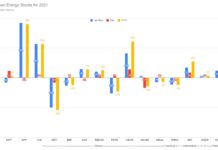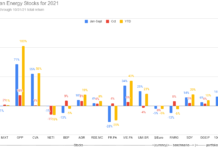Tom Konrad, CFA
Given the small size of its economy and rather lackluster approach to climate change, Canada has many of the Cleantech stocks with the best prospects. Canadian listed firms come from a broad range of sustainable sectors, and a lack of attention from United States investors means that many trade at very attractive valuations. Corporate Knights‘ has picked ten of the best.
I’m often surprised at how many of my favorite green stocks are listed in Canada. This year, two of my Ten Clean Energy Stocks for 2010 are Canadian listed. The same was true for my 2008 list, while my 2009 list contained three stocks from Canadian exchanges. I mostly stick to companies that are traded on North American exchanges, so it’s not surprising that more Canadian-listed companies appear than, say, companies listed in Britain (only one over three years.) It’s also surprising that there are so many Canadian listed firms, given that Canada’s economy is only about one tenth the size of the United States’ economy. Canada’s largest exchange, the TSX, has 3841 companies with a combined market capitalization of about $1.4 trillion, compared to 3615 $10.8 trillion for the NYSE and 2249 at $2.8 trillion for the NASDAQ.
The number of stocks on Canadian exchanges is key to the number of great Cleantech stocks listed there. While Canada’s relative market capitalization parallels the relative size of the economy, the number of Canadian listed stocks is about 2/3 of the number of stocks listed in the United States. Small companies often find that listing on the TSX is faster and easier, and often comes with less burdensome reporting rules than a NASDAQ listing [powerpoint pdf.] This means that American Cleantech investors interested in the many new companies going public find ourselves with relatively few options on US exchanges, while a bumper crop of Cleantech IPOs heads towards Canada.
However, the less burdensome listing requirements for Toronto listed firms are a two-edged sword: investors looking at these companies not only have to sift through more of them, but they need to be more careful with the ones they choose to consider in more detail. Many investors decide the extra work is not worth the bother, and stick to the relatively few US listed firms. Their reluctance is good for those of us willing to venture across the Northern border and do our homework: a smaller pool of investors means we can often buy these companies at much better valuations.
Sorting the Wheat from the Chaff
With many more Cleantech stocks to choose from, it helps to narrow down your focus on a few companies before doing the many hours of due diligence that should accompany any stock market investment. I often start with companies that are part of third party indexes. Beyond that, I tend to focus on a few Cleantech sectors such as Energy Efficiency Stocks, Clean Transportation Stocks, and Electric Grid stocks which get less attention than more popular sectors such as solar.
Companies in indexes have garnered enough shareholder attention that there will decent liquidity. This can be surprisingly important, even for a small investor. I became interested in a TSX-traded energy efficiency firm over the holidays, did hours of due diligence, and even wrote an article. The stock typically trades 1,000 to 2,000 shares a day, and I have only been able to buy 1700 shares at what I consider to be an attractive price. I’m waiting to publish the article until I’ve made my purchase. Given that the stock has risen since I bought it, I may never get the chance to buy more at the prices that prevailed when I did my research. Researching higher-liquidity stocks means that you can get in when you want without greatly moving the market.
The Cleantech 10TM
Corporate Knights calls itself “The Canadian Magazine for Responsible Business,” and they publish (in collaboration with The Cleantech Group) an annual list of ten “technology-driven growth companies that have big impacts on resource efficiency and the environmentnot simply those re-branding themselves as ‘green.’” By starting with a list like this one, I know I’m only looking at companies with businesses I would like to own. What I don’t know is if the stocks are good values, if they strong financially, or if management has the skills necessary to have them succeed against the competition. These latter three questions are the ones I try to answer during due diligence. In 2009, their list outperformed the TSX/S&P Composite by 38%.
They published the most recent Cleantech 10TM list in October 2009. With one replacement because of the buyout of Canadian Hydro Developers, here is their list, along with a few of my observations about each company. The first ticker is the Canadian ticker (in Canadian dollars,) and the second ticker is the US ticker, denominated in US$.
1. Westport Innovations (WPT.TO, WPRT)
Vancouver-based Westport trades on the NASDAQ as well as the Toronto Stock Exchange. This means the company may be less interesting to investors looking for less-noticed stocks. The company’s alternative engines and drive trains will probably do well if oil prices continue to rise. Although the company can fund about two year’s worth of operating cash losses from the balance sheet, I prefer profitable companies which are actively paying down their debt.
2. RuggedCom (RCM.TO, RUGGF.PK)
I took a close look at Smart Grid company Ruggedcom in November, and I concluded that, although I liked the business and had a generally good feeling about management, I felt it was overvalued at US$16.60. Since it’s currently trading around $20, I’m in no hurry to buy.
3. WaterFurnace Renewable Energy (WFI.TO, WFIFF.PK)
Waterfunace is a long-time favorite of mine, having appeared in both my own top stock lists in 2009 and 2010. In fact, I first learned about the Cleantech 10 list because it showed up in a news story about Waterfunace.
The Fort Wayne-based company manufactures a broad range of geothermal heat pumps, a clean energy technology that not only saves energy compared to other forms of heating and cooling a building, but also shifts electricity use to seasons during which wind based power is plentiful.
The company also provided me with some extra confirmation that US based investors tend to ignore Toronto listed companies: A contributing writer for the Motley Fool called me to ask about the company in January, after a relative had recommended one of their heat pumps for his home. He was researching it for his own portfolio, and when I asked him if he was likely to write about it, he said that he probably wouldn’t. The Motley Fool pays him to write articles that are likely to be popular, and, he said, that companies without US tickers don’t interest many of their readers.
4. Magma Energy Corp. (MXY.TO, MGMXF.PK)
Vancouver based Magma Energy Corp went public in July last year, with the intention of buying up interests in geothermal electricity projects. Geothermal is one of my favorite renewable energy sectors, since the electricity it produces is competitive with wind, but the power is much more reliable, but I have not yet taken the time to analyze Magma and decide if it’s a good value.
Montreal based 5N Plus provides purified metals, and is probably most interesting to investors because it supplies pure metals used in the Solar photovoltaic panels.
6. Carmanah Technologies Corp. (CMH.TO, CMHXF.PK)
Victoria based Carmanah manufactures LED lighting with integrated solar panels and batteries which allow for use in remote locations without a grid connection. Not having to lay wires for a grid connection means that Carmanah’s products are often the most cost effective lighting solution, despite the high cost of both the batteries and solar. I owned the stock from late 2005 until I sold it in September 2008 in response to the financial crisis, because I did not think that the company had the financial muscle to weather the storm.
The company last traded at $0.80, still below the $0.95 at which I sold despite almost doubling since March 2009, but I have not looked at the company again to see if they have done what I consider to be sufficient work repairing their balance sheet and cash flows.
7. NEO Material Technologies (NEM.TO, NEMFF.PK)
Toronto based NEO Material Technologies is one of the companies that made this whole exercise of going through the list worth doing. I was not previously aware of this manufacturer of rare-earth and Zirconium based magnets, which are used in high-performance electric motors (Recall John Petersen’s recent Storm Warning about the availability of rare earths for hybrid and electric vehicles.) Despite worries about rare earth supply, if NEO Materials is able to pass higher supply costs on to its customers, the company could be very profitable. Will it? Finding out is where the work comes in.
Also new to me is Edmonton based Stantec, a design firm geared towards sustainability. Stantec is worth further research because energy efficiency is more often about design than about products. In other words, design firms can often do more to reduce energy use than can be accomplished by simply slotting more efficient products into the same systems.
9. Hemisphere GPS (HEM.TO, HEMGF.PK)
Calgary based Hemisphere GPS manufactures GPS equipment for farming equipment which allows farmers to better gauge the amount of fertilizer or pesticide applied to a specific part of the field to the needs of the crop there. This more efficient use of resources not only improves the economics for the farmer, but is less wasteful and polluting to the environment.
10. Innergex Renewable Energy Inc. (INE.TO, INGXF.PK)
Innergex is a developer and operator of hydroelectric and wind projects, with the majority being hydroelectric. This makes the company an interesting play because the economics of upgrading old hydroelectric plants are far better than even building new coal plants, while new hydropower projects have economics that are comparable with the best other renewables, wind and geothermal. Like most of these, I have not looked at Innergex’s valuation, but I consider it worth a look.
The Cleantech 10 List from Corporate Knights on Vimeo.
Next Steps
NEO Materials, Stantec, Magma, and Innergex all are interesting enough to me that I may do further research. With interesting prospects like these, my next step is to start monitoring the news for these companies, and perhaps do a preliminary valuation based on simple metrics such as P/E, cash on hand, current ratio, and cash flow from operations. If the stock price falls to a point where the valuation looks good, and the news does not account for the change, it will be time to do the real work of reading through annual and quarterly reports.
DISCLOSURE: The author and/or his clients own WFI.
DISCLAIMER: The information and trades provided here are for informational purposes only and are not a solicitation to buy or sell any of these securities. Investing involves substantial risk and you should evaluate your own risk levels before you make any investment. Past results are not an indication of future performance. Please take the time to read the full disclaimer < a href="http://www.altenergystocks.com/disclosures.html">here.







